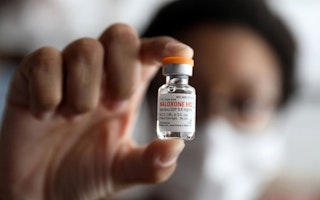Could the “Ithaca Plan” Become a Model for Harm Reduction in America?
By Matthew Wilson
A young man, 26 years old and white, stood and spoke. His back to the panel of experts, he addressed the crowded room of community members in Ithaca, New York, who had gathered to hear about the launch of a new municipal-level drug strategy. He was casually dressed, gaunt, and had a nervous quiver in his voice.
“Four hours ago,” he said, “I was lying on the floor, unconscious, overdosing on a bad bag of heroin.”
His left wrist was wrapped in a hospital bracelet, and a mound of gauze was taped to his right forearm where an IV had recently been withdrawn. After his overdose, his girlfriend found him, dragged him to the hospital, and saved his life. He had been using off and on for 10 years—attempts at detox and medication-assisted treatment had so far failed.
He had spent time in jail for his drug use and still struggled to manage his addiction. While in the hospital just a few hours before, a friend encouraged him to show up at a public event where a new drug policy for the city was being discussed.
Ithaca has launched a bold and innovative plan to address drug consumption. Structured around the four pillars of prevention, treatment, harm reduction, and public safety, the “Ithaca Plan” is a pragmatic approach to managing the challenges of drug use in the city. It envisions fact-based drug education, meaningful youth engagement, and economic development for at-risk communities.
It also seeks to improve access to low-threshold and harm reduction services for current drug users, including a nurse-monitored safe consumption room and a 24-hour crisis center. It promotes expanded treatment options and greater availability of medication-assisted therapies. It also allows police to divert drug users to social support services without arresting them. In short, the Ithaca Plan is built on evidence-based, public health–oriented drug policies.
Crucially, the Ithaca Plan is not built on the false hopes of one day living in a drug-free community. It’s not reliant on the unrealistic demand that all drug users kick the habit, nor does it attempt to arrest its way out of the problem. The plan is aware that, despite decades of coercive suppression efforts, drugs will continue to find their way to the city and into the bodies of those who desire them.
At the plan’s launch event, Mayor Svante Myrick said his concern for the health and lives of those in his community is what provided him the political will to pursue a different approach. A panel of experts and activists spoke about the history of the punitive Rockefeller drug laws in New York, their ineffectiveness at reducing drug use, and the appalling racial disparities in their enforcement.
The recent shift from a criminal justice– to a public health–based response now that white communities are more publicly affected, while welcomed by the panel, was not overlooked. Some spoke of the rise in heroin use as people move from prescription pain medication to cheaper and more readily available street drugs. The panel highlighted the successful precedents of the “four pillars approach” in cities like Vancouver, Frankfurt, and Geneva, and of the promising results of the Law Enforcement Assisted Diversion (LEAD) program in Seattle.
The young man’s unlikely presence at the event and sheer luck in still being alive highlighted vividly for the audience the perils of addiction, black market drugs, and risky consumption practices. His presence was also testament to the ability of the human body to rebound and recover with timely intervention. His girlfriend was proof that the right support at the right time can save a life.
“Many of us can’t just stop using,” he continued, “and people will keep getting drugs no matter what you do. What we need is a safe place to use and services that accept and meet us where we are today.”
His intervention was powerful because in the eyes of the audience, he could have been their son, their brother, or their friend. He was a stranger who used drugs and courageously exposed his humanity to the community, shared his predicament, and asked for their help.
What will Ithaca do? They have a solid plan and political leaders with the will to move it forward. But actions speak louder than words. The real fight begins now. Community support needs to be mobilized, funding found, and legal constraints overcome.
What will Albany and Washington, D.C., do? Right now, several crucial aspects of the Ithaca Plan contravene state and federal laws. This needs to change. The evidence is clear that the interventions proposed by Ithaca work [PDF]. They lead to better health and social outcomes, fewer criminal records, and lives and money saved. It’s time for state and federal policy makers to show the same courage as elected officials in Ithaca.
What will the United Nations do? Drugs are a global commodity—the heroin in Ithaca originates from the other side of the world despite hundreds of billions of dollars spent trying to stem the flow. In many places, conflict, corruption, risky drug use, and rising HIV and hepatitis C rates are only a few of the challenges aggravated by an unrealistic war on drugs. With the United Nations General Assembly Special Session on drugs (UNGASS) taking place in April, it is time for member states to endorse a new approach. The Ithaca Plan, like those that came before it, points the way forward.
Now is the moment—from the local to the global level—to stop the harm that stems from poorly designed drug policies and get moving in the right direction.

Matthew Wilson is division director of Equity for Global Programs at the Open Society Foundations.

